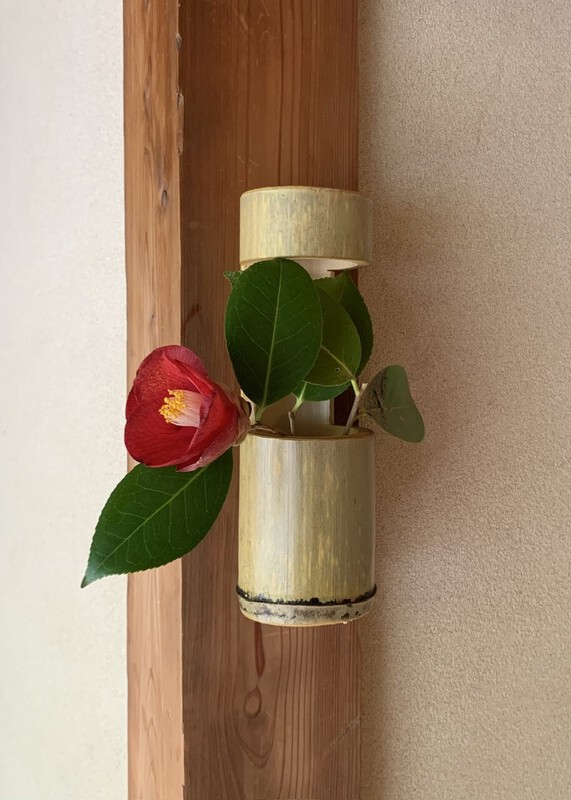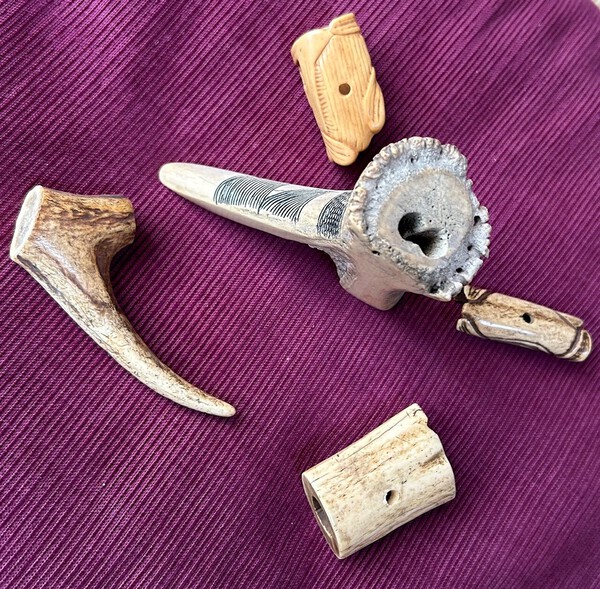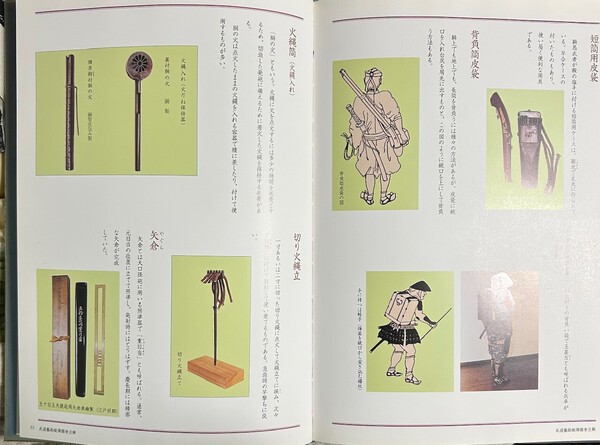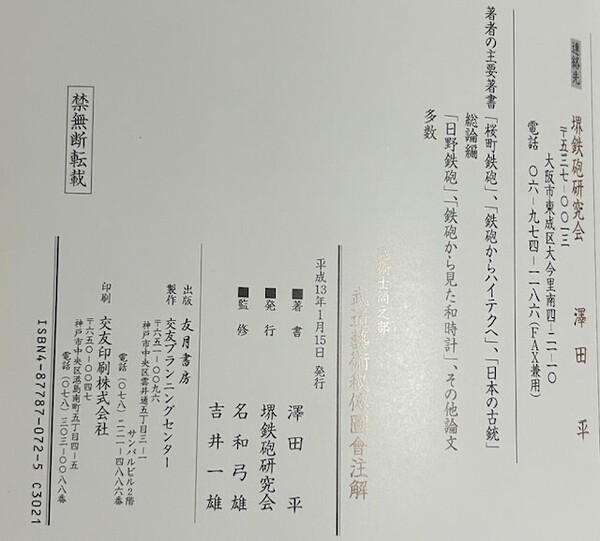-
Posts
14,157 -
Joined
-
Last visited
-
Days Won
265
Content Type
Profiles
Forums
Events
Store
Downloads
Gallery
Everything posted by Bugyotsuji
-
John, there were both brass and iron, and some silver. One came up at auction some years back and I stopped bidding at £600… They have shot up in value.
-
-
Ultimately almost anything could have been used as a Netsuke, including fishing net weights. I have several primitive objects which were probably used that way. These are the only stag antler bits here at the moment, from my odds ‘n ends box, but one has that straight-cut section. Some may be Ainu work. and over
-
Sadly no, John. I have seen many of them in different shapes, usually with that straight-cut piece(?) missing. Some kind of whistle I used to think, but no-one has yet provided a satisfactory answer. Can anyone help?
-
忍者 Can be read either ‘Shinobi mono’ or ‘Ninja’, often shortened in speech to ‘Shinobi’. A woman in this role could be referred to as ‘Kunoichi’ = く ノ 一 (The sound suggests possibly: ‘First in suffering’, or ‘one of the most stressful things in life’) Write those three sounds in order and you get 女 Onna.
-

NBTHK hozon Bitchu Matsuyama-jū Kunishige Wakizashi
Bugyotsuji replied to Lexvdjagt's topic in Swords and Edged Weapons
If you are ever in the area of Takahashi, a hike up to Bitchū Matsuyama Castle is quite rewarding. -
You need to spend quality time looking through collections, at photos in books, in museums (Pietro has a huge list of links) or/and in direct handling sessions. Gradually you will begin to ‘see’ with your own eyes what original Netsuke were. As with Nihonto, you need to see many good blades in order to develop an eye. It is hard to make progress looking only at poor quality blades. PS And some Netsuke I see are still borderline for me… i.e. very difficult to judge.
-

Accessories for the Tanegashima
Bugyotsuji replied to Bugyotsuji's topic in Tanegashima / Teppo / Hinawajū
If anyone is wondering what something is, everything on the list at the start of this thread can be illustrated if necessary. Even battered and bruised… -
Yes, it’s upside down Japanese, but sadly no, I can’t read it.
-
Ninja Rule Number One Leave no proof you ever existed.
-
Well spotted! As I said before, *many guns do not have hinawa-tōshi ana so this must be an artist’s overall concept, but I suppose if you do, then it stops the cord from being blown around, especially if it’s raining and the ground is wet. I have a private theory that these holes became more common as the Edo period progressed. As to the horse’s head, they must have trained them to put up with loud noises, although the quietest place is behind the barrel, relatively speaking. Even so the horse does look a bit uncertain. Talking of horses, just today someone gave me a heavy bajōzutsu ‘carbine’ with an udé-nuki-no-kan hole in the stock. 1.7 cm bore *About 15% of my long smoothbore Tanegashima have Himotōshi holes.
-
Sadly, Colin is correct. The rich are not always wise. I hate to think what your yacht owner paid. Unfortunately these NLO are often made of real ivory, feeding the illegal ivory market.
-
I suspect that Japanese artisans got ideas from seeing these, though.
-
Roland, Sawada San seems to have used the same book you mentioned above. As to the Taté shields, yes. Actually they soon found bundles of bamboo to be more effective against ball when larger guns were able to penetrate old-fashioned wooden shields. In Osaka Castle they also keep a heavy iron self-standing shield in the same shape as those above.
-
You’re correct. There do not seem to be many silver menuki. I still have two pairs but very different themes. I’m not sure how well gold plates onto silver.. (?)
-

Accessories for the Tanegashima
Bugyotsuji replied to Bugyotsuji's topic in Tanegashima / Teppo / Hinawajū
Yesterday a friend asked me if I would be willing to part with a dōran waist box. My best one! In exchange he offered me a nice kayaku-iré blackpowder flask and an adjustable iron candle stand. Well, he knows my weaknesses… -

Accessories for the Tanegashima
Bugyotsuji replied to Bugyotsuji's topic in Tanegashima / Teppo / Hinawajū
Gary (Tengu) has a nice collection above. -

Accessories for the Tanegashima
Bugyotsuji replied to Bugyotsuji's topic in Tanegashima / Teppo / Hinawajū
John, shot would have been used in the same way for small game, yes. Of course they did not have cartridges as we know them, so, as in the early days of the Wild West, a powder charge would first be poured down the barrel, followed by a load of lead pellets, maybe in some paper wadding to keep the load compact. Trawling some antiques fairs etc. will gradually build your collection. Step by step one gets to Rome! PS I you can get hold of the *Ogawa Collection, you will see many interesting examples of the kind of thing we look for, accessories of the ashigaru and castle lord. * and -
Tottori Prefecture. Quite a low registration number, close to the start of the ‘new’ registration system.
-

Edo Period Corner Part II
Bugyotsuji replied to estcrh's topic in General Nihonto Related Discussion
And the bad news is that a friend told me that once they get your name on the register they will ask you again the following year, and it will be hard to refuse. This means that from now on it is likely that I will have to do the above display or something equivalent every year, unless I can come up with a good excuse. Hmmm… -

Edo Period Corner Part II
Bugyotsuji replied to estcrh's topic in General Nihonto Related Discussion
篠垂 Shinodare are generally decorative strips on kabuto running from the tehen down towards the bottom edge of the hachi bowl. Tare is from the verb tareru, to hang, or dribble or run down as a liquid. Shino means bamboo, but the word also indicates thin upright strips or ribs of bamboo (or metal) as those of Sune-ate, that protected the shins. Decorative glazing strips for a kabuto. -
These are all good questions, Roland. To answer in detail would take much time, but the hinawa handling secrets of each school of gunnery were slightly different, and may be found in scrolls which sometimes turn up. My training never mentioned use of hinawa-tōshi holes, (although my trusty Kumamoto gun does have such a passage through the upper stock) so it must have been an option for some, or perhaps a convenient place to put the cord while waiting for battle of even for storage or display. Not every gun has these holes. The picture you have chosen above shows the hands the wrong way round. Perhaps this was a special technique for loading when squatting low. It is possible that they are loading before battle, and before lighting their matches. Normally Japanese matchlock cord is of high quality and does not go out, so only one end is lit, the coil is kept on the left forearm, the gunner is standing, and the lit end is in the left fingers. (This changes for a matchlock pistol, and there are tricks for rainy weather.) Cord can also be cut short (Kiri hinawa), with several kept on a special group stand, disposable, handed out for each shot. There were also special metal tubes (called hinawa-ire, do-no-hi etc.) kept at the waist, which held burning cord, saving the time to light one in emergency situations. If you can find a copy of Sawada Taira’s green book, there are many illustrations, though not so many showing burning cords. PS I have been an active member of an old Japanese matchlock troop for over twenty years.
-

Did the Japanese use patched roundballs in teppo?
Bugyotsuji replied to Rolland's topic in Tanegashima / Teppo / Hinawajū
Better late than never! (Besides, my answer to you above took the best part of a year… ) -

Accessories for the Tanegashima
Bugyotsuji replied to Bugyotsuji's topic in Tanegashima / Teppo / Hinawajū
Having given a recommendation concerning what state or condition of powder flask is best, I came across a ‘why bother?’ one that is more typical, well used, with replaced parts. Why did I buy it? See what the ball bag contained. Small round shot, backing up previous discoveries of shotgun pellet usage. (See 22 May 2019 post above.)














